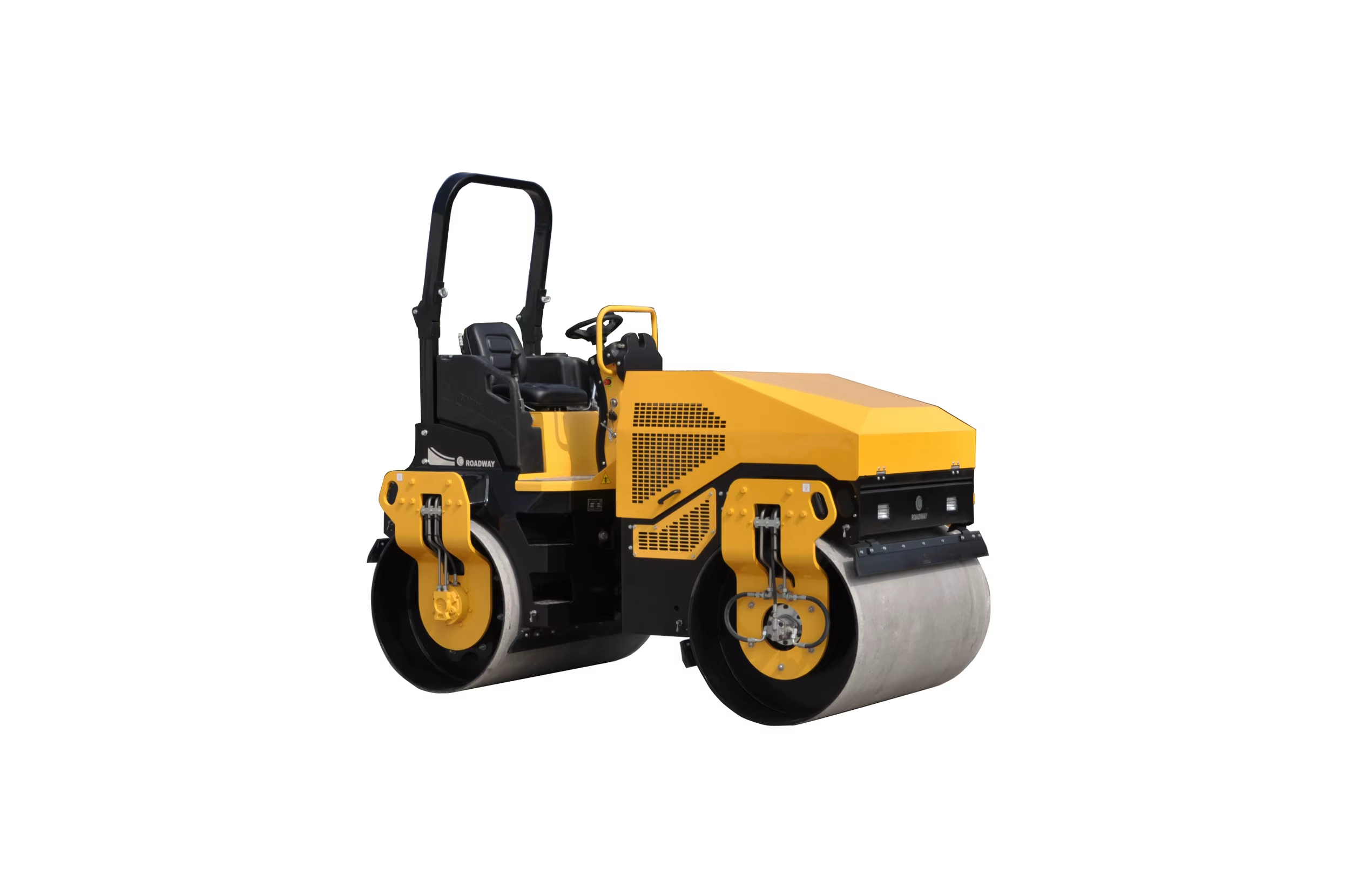วิธีที่เครื่องอัดดินแบบสั่นสะเทือนเพิ่มประสิทธิภาพการอัดแน่น
หลักการทำงานพื้นฐานของเครื่องอัดดินแบบสั่นสะเทือนในการอัดแน่นดินและยางมะตอย
เมื่อต้องการผลลัพธ์ที่ดีในการบดอัด รถอัดดินแบบสั่นสะเทือนจะทำงานได้อย่างมีประสิทธิภาพโดยการรวมน้ำหนักถ่ายลงปกติกับแรงสั่นสะเทือนที่ทรงพลัง กลองหมุนของเครื่องจักรเหล่านี้สร้างแรงสั่นสะเทือนซึ่งช่วยเคลื่อนย้ายอนุภาคในดินทรายหรือดินกรวดให้เรียงตัวกันดีขึ้น ในขณะเดียวกันก็ช่วยบีบอากาศออกจากผิวแอสฟัลต์ได้ เมื่อเทียบกับเทคนิคแบบดั้งเดิมที่ใช้มือหรือการปล่อยน้ำหนักกระทบลงบนพื้นผิว การเคลื่อนไหวไปมาเช่นนี้ทำให้เกิดความแตกต่างอย่างชัดเจน จากรายงานของผู้รับเหมาส่วนใหญ่ระบุว่าสามารถบรรลุเป้าหมายความหนาแน่นที่ยากต่อการเข้าถึงได้ระหว่าง 95% ถึง 98% สำหรับดินที่ถูกบดอัดแล้ว ตามรายงานอุตสาหกรรมปีที่แล้ว และพวกเขายังสามารถทำได้แม้จะทำงานบนพื้นที่ขรุขระที่ไม่เรียบสมบูรณ์
หลักการทำงานของการสั่นสะเทือน: การถ่ายโอนพลังงาน การจัดเรียงอนุภาคใหม่ และผลกระทบจากเรโซแนนซ์
เมื่อทำงานกับวัสดุ การสั่นสะเทือนความถี่สูงซึ่งมักอยู่ในช่วงประมาณ 1,800 ถึง 4,000 ครั้งต่อนาที จะส่งพลังงานจลน์ลงไปยังชั้นลึกของวัสดุ ซึ่งช่วยจัดเรียงเม็ดวัสดุให้อยู่ในแนวที่เหมาะสม โดยเฉพาะอย่างยิ่งสำหรับยางมะตอย การสั่นสะเทือนเหล่านี้จะสร้างผลเรโซแนนซ์ระหว่างอนุภาคของหินผสม ทำให้เติมช่องว่างเล็กๆ เหล่านั้นได้โดยไม่ทำลายตัวสารยึดเกาะ เมื่อปีที่แล้ว ForConstructionPros ระบุว่า อุปกรณ์รุ่นใหม่สามารถปรับความถี่ได้สูงสุดถึง 4,000 VPM ซึ่งช่วยให้ผู้ปฏิบัติงานสามารถปรับแต่งการตั้งค่าให้เหมาะสมกับความหนาของชั้นวัสดุและระดับความแข็งของวัสดุนั้นๆ ได้อย่างแม่นยำ ส่งผลให้งานมีประสิทธิภาพดียิ่งขึ้น
เครื่องอัดแบบสั่น หรือแบบสถิต: ความแตกต่างหลักและข้อได้เปรียบในการทำงาน
| สาเหตุ | เครื่องอัดแบบสั่น | รถกลิ้งแบบสถิต |
|---|---|---|
| ความลึกของการอัด | สูงสุด 1.5 เมตร | 0.3–0.6 เมตร |
| ความเร็วของโครงการ | วงจรการผลิตเร็วขึ้น 30% | เอาต์พุตแบบคงที่ |
| ความหลากหลายของวัสดุ | ใช้งานกับดินชนิดยึดเกาะและยางมะตอยได้ | จำกัดเฉพาะชั้นฐานวัสดุเกรน |
เครื่องอัดดินแบบสั่นสะเทือนต้องการจำนวนครั้งในการอัดเพียง 40% ของรุ่นธรรมดา แต่ให้ความหนาแน่นสูงขึ้น 8–12% ในดินเหนียวปนทราย (NATO 2023) ข้อได้เปรียบเหล่านี้ทำให้เครื่องมือชนิดนี้จำเป็นอย่างยิ่งสำหรับการใช้งานในขนาดใหญ่ เช่น การก่อสร้างทางหลวงและการปูรองพื้นที่ฝังกลบ
หลักวิทยาศาสตร์ของการสั่นสะเทือนและการตอบสนองของวัสดุ
ผลกระทบของการสั่นสะเทือนต่อการจัดเรียงตัวของอนุภาคดินและความหนาแน่น
เมื่อการสั่นสะเทือนแบบไดนามิกทำให้เกิดแรงสั่นสะเทือน มันจะช่วยคลายโครงสร้างของดินชั่วคราว ทำให้อนุภาคสามารถจัดเรียงตัวเองใหม่ให้แน่นขึ้นรายงานล่าสุดจาก Geotechnical Materials ในปี 2023 ยังแสดงผลที่น่าสนใจอีกด้วย โดยดินชนิดยึดเกาะกันได้สามารถบรรลุความหนาแน่นได้ระหว่าง 92 ถึง 96 เปอร์เซ็นต์ เมื่อมีการสั่นสะเทือนอย่างเหมาะสม ซึ่งสูงกว่าวิธีการอัดแน่นแบบสถิตย์ทั่วไปประมาณ 15% สำหรับดินประเภทเม็ด เช่น ทราย การเลือกความถี่ของการสั่นสะเทือนให้เหมาะสมมีความสำคัญมาก เมื่อความถี่ตรงกับค่าธรรมชาติของวัสดุ อนุภาคจะเคลื่อนที่ได้อย่างอิสระมากขึ้น ส่งผลให้เกิดการเชื่อมโยงกันได้ดีขึ้น และทำให้โครงสร้างโดยรวมมีความมั่นคงมากยิ่งขึ้นในระยะยาว
พลวัตของการสั่นสะเทือนในแอสฟัลต์: การลดช่องว่างอากาศและป้องกันการแยกตัวของวัสดุ
การสั่นสะเทือนความถี่สูงระหว่าง 25 ถึง 40 เฮิรตซ์ ก่อให้เกิดการไหลชั่วคราวในส่วนผสมของยางมะตอย ซึ่งช่วยให้อนุภาคหินเคลื่อนตัวได้ดีขึ้น โดยยังคงป้องกันไม่ให้อนุภาคแยกออกจากกันมากเกินไป การศึกษาล่าสุดในปี 2024 เกี่ยวกับการอัดแน่นของยางมะตอยแสดงให้เห็นว่าการออกแบบลูกกลิ้งแบบสั่นสะเทือนสามารถลดความเสียหายที่เกิดจากเรโซแนนซ์ลงได้ประมาณ 34 เปอร์เซ็นต์ เมื่อเทียบกับโมเดลอุปกรณ์รุ่นเก่า เมื่อผู้ปฏิบัติงานรักษาระดับแอมพลิจูดที่เหมาะสมไว้ที่ประมาณ 0.5 มิลลิเมตร ถึง 2 มิลลิเมตร ลูกกลิ้งพิเศษเหล่านี้จะกระจายแรงออกไปอย่างสม่ำเสมอบนพื้นผิว โดยไม่ทำให้อนุภาคหินแตกหรือเสียรูป ส่งผลให้ได้ค่าปริมาณช่องว่างอากาศที่เหมาะสมอยู่ที่ประมาณ 3 ถึง 7 เปอร์เซ็นต์ เพื่อประสิทธิภาพที่ดีที่สุด
การปรับแต่งความถี่และแอมพลิจูดให้เหมาะสมกับชนิดวัสดุต่างๆ
| ประเภทวัสดุ | ช่วงความถี่ที่เหมาะสม | ค่าเกณฑ์แอมพลิจูด |
|---|---|---|
| ดินเหนียว | 25–30 Hz | 1.2–1.8 mm |
| ดินเม็ดหยาบ | 30–40 Hz | 0.8–1.5 mm |
| ส่วนผสมแอสฟัลต์ | 35–45 เฮิรตซ์ | 0.5–1.2 มม. |
วัสดุแบบเม็ดตอบสนองได้ดีที่สุดต่อความถี่สูง ในขณะที่แอมพลิจูดต่ำจะช่วยป้องกันการอัดแน่นเกินไปในชั้นวัสดุที่มีความละเอียดหรือชั้นที่ยึดเกาะกันได้ดี
ความเสี่ยงจากการสั่นสะเทือนมากเกินไป และกลยุทธ์ในการหลีกเลี่ยงความเสียหายของวัสดุ
การสั่นสะเทือนมากเกินไปสามารถทำให้อนุภาคของแอสฟัลต์แตกร้าว หรือทำให้อนุภาคพื้นดินเด้งกลับ ส่งผลให้ความหนาแน่นลดลงได้สูงสุดถึง 12% เพื่อป้องกันความเสียหาย ผู้ปฏิบัติงานควรตรวจสอบข้อมูลจากเซ็นเซอร์แบบเรียลไทม์ และใช้ระบบตัดการทำงานอัตโนมัติ ซึ่งจะทำงานเมื่อถึงค่าความหนาแน่นเป้าหมายแล้ว
ประโยชน์หลักของการใช้เครื่องอัดดินแบบสั่นสำหรับคุณภาพการอัดแน่นระยะยาว
การบรรลุความหนาแน่นและความแข็งแรงของโครงสร้างในชั้นดิน
การอัดแน่นด้วยแรงสั่นสะเทือนช่วยลดช่องว่างในดินยึดเหนี่ยวได้สูงสุดถึง 15% เมื่อเทียบกับการอัดด้วยลูกกลิ้งแบบสถิต (วารสารวิศวกรรมชั้นดิน 2023) ทำให้เกิดโครงสร้างที่แนบชิดกันอย่างมั่นคง ทนต่อการซึมผ่านของน้ำและการกัดเซาะ สำหรับคันดินและรากฐาน การเพิ่มการอัดแน่นขึ้นเพียง 1% จะเพิ่มความต้านทานแรงเฉือนได้ 5–8 กิโลปาสกาล ซึ่งช่วยปรับปรุงสมรรถนะในการรับน้ำหนักระยะยาวอย่างมีนัยสำคัญ
ความทนทานที่ดีขึ้นและการเปลี่ยนรูปที่ลดลงในพื้นผิวแอสฟัลต์
เมื่อผิวแอสฟัลต์ได้รับการสั่นสะเทือนความถี่สูงในช่วง 25 ถึง 40 เฮิรตซ์ แรงเสียดทานจะสร้างจุดร้อนที่ช่วยให้วัสดุผสมขยับตัวได้ดีขึ้นระหว่างกระบวนการบดอัด การควบคุมการสั่นสะเทือนให้เหมาะสมจะช่วยลดช่องว่างอากาศในส่วนผสมให้ต่ำกว่า 5 เปอร์เซ็นต์ ซึ่งมีความสำคัญอย่างยิ่ง เพราะหากมีช่องว่างอากาศมากเกินไป จะทำให้เกิดหลุมเป็นร่องและวัสดุเสื่อมสภาพเร็วกว่าปกติ การศึกษาจากหลาย ๆ การทดสอบภาคสนามชี้ให้เห็นว่า ถนนที่ใช้อุปกรณ์สั่นสะเทือนในการกลิ้งอัดแน่นจะมีความทนทานมากกว่าในระยะยาว หลังจากมีรถบรรทุกวิ่งผ่านอย่างต่อเนื่องประมาณห้าปี พื้นผิวเหล่านี้แสดงอาการแตกร้าวและการเปลี่ยนรูปน้อยลงประมาณ 30 เปอร์เซ็นต์ เมื่อเทียบกับเทคนิคการบดอัดแบบไม่สั่นสะเทือนแบบดั้งเดิมที่ใช้บนถนนคล้ายกัน
ประสิทธิภาพในระยะยาวที่เพิ่มขึ้นจากการบดอัดที่สม่ำเสมอและมีคุณภาพสูง
ด้วยการรักษาระดับความหนาแน่นแบบโปรคเตอร์ที่ปรับแล้วไว้ที่ 95–98% ทั่วทั้งพื้นที่ เครื่องอัดดินแบบสั่นสะเทือนช่วยป้องกันการทรุดตัวไม่สม่ำเสมอ ซึ่งเป็นปัจจัยที่ทำให้เกิดค่าใช้จ่ายในการซ่อมแซมโครงสร้างพื้นฐานถึง 43% (ตามรายงานของสภาการวิจัยด้านการขนส่ง ปี 2022) ผลลัพธ์ที่สม่ำเสมอของเครื่องจักรเหล่านี้ยังช่วยยืดอายุการใช้งานผิวทางเพิ่มขึ้นอีก 8–12 ปี ในสภาพอากาศอบอุ่น ตามการศึกษาระยะยาว 15 ปี บนเครือข่ายทางหลวง

แนวทางปฏิบัติที่ดีที่สุดสำหรับการใช้เครื่องอัดดินแบบสั่นสะเทือนในงานแอสฟัลต์และดิน
การอัดแน่นแอสฟัลต์: การควบคุมช่วงเวลาการสั่นสะเทือนให้สอดคล้องกับอุณหภูมิของแผ่นแอสฟัลต์และคุณสมบัติของส่วนผสม
การเริ่มต้นกระบวนการสั่นสะเทือนเมื่อพื้นผิวแอสฟัลต์มีอุณหภูมิอยู่ที่ประมาณ 275 ถึง 300 องศาฟาเรนไฮต์ (ซึ่งเท่ากับประมาณ 135 ถึง 149 องศาเซลเซียส) สามารถเพิ่มประสิทธิภาพการล็อกตัวของหินคลุกได้ระหว่าง 18 ถึง 22 เปอร์เซ็นต์ สิ่งสำคัญคือชนิดของวัสดุที่เราใช้งาน เช่น ผสมผสานที่มีกราไนต์จำนวนมากจะให้ผลดีกว่าเมื่อใช้การสั่นสะเทือนความถี่ต่ำ โดยทั่วไปอยู่ที่ 1,500 ถึง 1,800 การสั่นสะเทือนต่อนาที ซึ่งจะช่วยป้องกันปัญหาการแตกร้าว ในทางกลับกัน สารผสมที่ใช้หินปูนเป็นฐานสามารถทนต่อช่วงการสั่นสะเทือนที่สูงกว่าได้ โดยปกติอยู่ที่ 2,200 ถึง 2,500 VPM โดยไม่มีปัญหา ตามงานวิจัยล่าสุดที่ตีพิมพ์ในรายงาน Asphalt Performance Study ปี 2023 การควบคุมจังหวะเวลาของการสั่นสะเทือนอย่างเหมาะสมจะช่วยลดช่องว่างอากาศในส่วนผสมลงเหลือเพียง 3 ถึง 5 เปอร์เซ็นต์ ซึ่งส่งผลอย่างมากต่ออายุการใช้งานของถนน โดยยืดอายุการใช้งานออกไปได้ประมาณ 30 เปอร์เซ็นต์ เมื่อเทียบกับวิธีการอัดแน่นแบบสถิติแบบดั้งเดิม
รูปแบบการกลิ้งที่มีประสิทธิภาพเพื่อความเรียบเนียนและพื้นที่ครอบคลุมอย่างสม่ำเสมอ
เมื่อทำงานกับอุปกรณ์ ควรทับซ้อนแต่ละช่วงประมาณ 15 ถึง 20 เปอร์เซ็นต์ของพื้นที่ที่ลูกกลิ้งคลุม และเคลื่อนที่ช้ากว่า 3 ไมล์ต่อชั่วโมง (ประมาณ 4.8 กิโลเมตรต่อชั่วโมง) เพื่อให้ผิวเรียบสม่ำเสมอ สำหรับพื้นที่ลาดเอียง ผู้ปฏิบัติงานควรใช้รูปแบบแนวฟันปลาเป็นรูปตัว V เพราะจะช่วยป้องกันวัสดุจากการไหลลงเนิน ส่วนพื้นราบควรใช้การทับในแนวเส้นตรงแทน เครื่องจักรรุ่นใหม่ที่ติดตั้งระบบพวงมาลัยอัตโนมัติช่วยให้ผลลัพธ์ดีขึ้นอย่างมาก การทดสอบแสดงให้เห็นว่า ระบบขั้นสูงเหล่านี้สามารถทำให้ผิวหน้ามีความสม่ำเสมอกว่าเดิมมาก ใกล้เคียงกับความสม่ำเสมอ 99 เปอร์เซ็นต์ในสภาพแวดล้อมห้องปฏิบัติการ แม้ว่าผลลัพธ์จริงอาจแตกต่างกันไปตามลักษณะภูมิประเทศและทักษะของผู้ปฏิบัติงาน
การอัดดินทีละชั้น: การปรับตั้งค่าเพื่อผลลัพธ์ที่เหมาะสมที่สุด
| ประเภทของดิน | แอมพลิจูดที่แนะนำ | ความหนาชั้นดิน | จำนวนรอบการทับ |
|---|---|---|---|
| สันติ | สูง (1.8–2.2 มม.) | 8–12" (20–30 ซม.) | 4–6 |
| ดินเหนียว | ต่ำ (0.6–1.0 มม.) | 6–8" (15–20 ซม.) | 8–10 |
สภาพแวดล้อมมีผลต่อผลลัพธ์: ชั้นดินเหนียวในฤดูฝนต้องการจำนวนรอบการอัดน้อยลงเพื่อหลีกเลี่ยงการอิ่มตัว ในขณะที่สภาวะแห้งอาจต้องการระยะเวลาการสั่นสะเทือนนานขึ้น 10–15%
เทคนิคภาคสนามจากผู้นำอุตสาหกรรม
แนะนำให้ใช้ระบบซิงโครไนซ์กลองคู่สำหรับการเปลี่ยนผ่านระหว่างดินยึดเกาะและยางมะตอยบริเวณทางเข้าสะพาน เพื่อรักษาความหนาแน่นไว้ที่ 95% ที่จุดต่อประสาน การตรวจสอบแบบก้าวหน้าโดยใช้เครื่องอัดดินที่รองรับ IoT—ปัจจุบันถูกใช้งานโดยผู้รับเหมาระดับท็อป 62%—ช่วยลดงานแก้ไขโดยการระบุพื้นที่ที่อัดไม่เพียงพอได้แบบเรียลไทม์
ประสิทธิภาพในการดำเนินงานและความคุ้มค่าของกระบวนการอัดด้วยแรงสั่นสะเทือน
การประหยัดเวลาและแรงงานในโครงการโครงสร้างพื้นฐานขนาดใหญ่
รถอัดดินแบบสั่นสะเทือนทำงานอัดแน่นได้เร็วกว่า เร็วกว่า 30–50% เมื่อเทียบกับทางเลือกแบบสถิต ตามการวิเคราะห์อุตสาหกรรมปี 2023 จำนวนรอบที่ลดลงหมายถึงวงจรการทำงานของเครื่องจักรและชั่วโมงการทำงานของผู้ควบคุมที่ลดลง บนโครงการทางหลวงหลายไมล์ ผู้รับเหมาสามารถประหยัด 220–300 ชั่วโมงแรงงาน ต่อเฟส นอกจากนี้ คุณภาพที่ดีตั้งแต่รอบแรกยังช่วยลดงานแก้ไข ลดความล่าช้าและต้นทุนที่เกี่ยวข้อง
คำถามที่พบบ่อย
ข้อดีหลักของการใช้เครื่องอัดดินแบบสั่นสะเทือนแทนเครื่องอัดดินแบบสถิตคืออะไร
เครื่องอัดดินแบบสั่นสะเทือนมีข้อได้เปรียบ เช่น ความลึกในการอัดตัวที่มากขึ้น ความเร็วในการทำงานของโครงการที่สูงขึ้น และความหลากหลายของวัสดุ ช่วยให้ได้ความหนาแน่นสูงขึ้นโดยใช้จำนวนรอบการอัดน้อยลง ทำให้เหมาะสำหรับงานขนาดใหญ่ เช่น การก่อสร้างทางหลวง
เครื่องอัดดินแบบสั่นสะเทือนช่วยปรับปรุงความทนทานระยะยาวของผิวแอสฟัลต์ได้อย่างไร
เครื่องอัดดินแบบสั่นสะเทือนช่วยลดช่องว่างในอากาศและป้องกันการแยกชั้นของวัสดุในผิวแอสฟัลต์ ส่งผลให้พื้นผิวมีการแตกร้าวและการเสียรูปน้อยลงถึง 30% ตลอดเวลา ซึ่งช่วยเพิ่มความทนทานระยะยาวและอายุการใช้งานของผิวจราจร
ความถี่ใดเหมาะสมที่สุดสำหรับการอัดตัวของวัสดุประเภทต่างๆ
สำหรับดินยึดเหนี่ยว ความถี่ที่เหมาะสมคือ 25-30 เฮิรตซ์ ในขณะที่ดินแบบเม็ดควรใช้ความถี่ 30-40 เฮิรตซ์ ส่วนส่วนผสมแอสฟัลต์จะให้ผลดีที่สุดที่ความถี่ 35-45 เฮิรตซ์ การปรับความถี่ช่วยให้ได้ผลการอัดตัวที่เหมาะสมกับวัสดุแต่ละประเภท
สารบัญ
- วิธีที่เครื่องอัดดินแบบสั่นสะเทือนเพิ่มประสิทธิภาพการอัดแน่น
- หลักวิทยาศาสตร์ของการสั่นสะเทือนและการตอบสนองของวัสดุ
- ประโยชน์หลักของการใช้เครื่องอัดดินแบบสั่นสำหรับคุณภาพการอัดแน่นระยะยาว
- แนวทางปฏิบัติที่ดีที่สุดสำหรับการใช้เครื่องอัดดินแบบสั่นสะเทือนในงานแอสฟัลต์และดิน
- ประสิทธิภาพในการดำเนินงานและความคุ้มค่าของกระบวนการอัดด้วยแรงสั่นสะเทือน
- คำถามที่พบบ่อย

